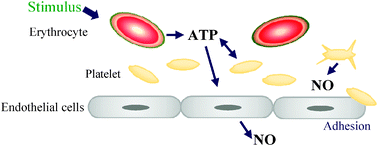Patient groups subject to higher occurrence of stroke (e.g., people with diabetes, cystic fibrosis, pulmonary hypertension) have reduced release of ATP from their erythrocytes (ERYs) when subjected to flow-induced deformation or pharmacological stimuli. These same groups also have platelets that are more adhesive in comparison to controls. Here we show platelet aggregation, and inhibition of that aggregation, is affected by free Ca2+ entering the platelet through the ATP-gated P2X1 receptor. The addition of ATP (10 μM) increased the platelet NO by 26.7 ± 7.7%. This value was decreased significantly to below basal levels in the presence of NF 449 (p < 0.001), an inhibitor of the P2X1 receptor on the platelet. Aggregation profiles measured in the presence of ATP revealed that when the P2X1 receptor was blocked, or when the measurements were performed in Ca2+ free buffer, platelet aggregation was nearly eliminated. Our findings employing standard aggregation measurements suggest that ATP behaves as a platelet inhibitor below 1.6 × 10−19 moles ATP per platelet; however, above this value, ATP behaves as a platelet activator. These findings suggesting a dual nature of ATP with regard to platelet behavior were confirmed by passing platelets over endothelial cells that were coated in the channels of a microfluidic device. Importantly, it was determined that ERY-derived ATP release was a major determinant of platelet adhesion to the endothelium. These findings may have implications in anti-platelet drug design as most current therapies focus on the inhibition of P2Y-type receptors. Moreover, through the use of microfluidic technologies, we have provided in vitro evidence for a possible relationship between ERY properties and platelet behavior in vivo.

You have access to this article
 Please wait while we load your content...
Something went wrong. Try again?
Please wait while we load your content...
Something went wrong. Try again?


 Please wait while we load your content...
Please wait while we load your content...